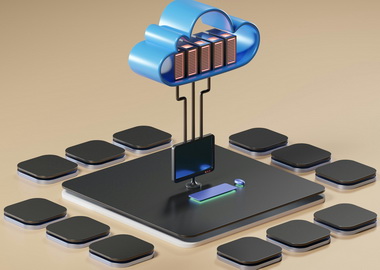Migrating Legacy Applications to the Cloud: Guide to Risk-Free Migration
Cloud migration is a future-proof strategy for aging applications. This transition leads to easy and effective scalability, business agility, and improved security. No wonder 86% of companies are increasing their investment in cloud, year after year.
But migrating legacy applications to the cloud is a complicated and expensive journey fraught with challenges and risks. You need a thought-out strategy and calculated migration roadmap to safely move to the cloud, without drowning in cost overruns and complexities.
To help you take the first steps in the right direction, I want to share the proven blueprint for an effective legacy migration. I will also highlight major risks and roadblocks you may come across and ways to remove them.
Before we get there, let’s quickly go through the basics and benefits of legacy to cloud migration. If you are at the point in your journey when you already know what you want to achieve from this transition, feel free to skip straight to a risk-free implementation plan.
Cloud migration refers to moving workloads, applications, and data from on-premises to a cloud environment or from one cloud to another.
In the first scenario, the common goals for shifting from on-premises to the cloud are easier scalability, trouble-free maintenance and infrastructure management, and improved security. In the second scenario, cloud application migration from one provider to another may offer better pricing or stronger security.
Another reason to change cloud providers is improved compatibility and compliance. For instance, when companies go through acquisition or merger and move to one cloud. Or when a company needs to gather scattered services, applications, and technologies into a unified platform.
Either way, the key goal of this transition is to improve systems and processes that no longer cut the mustard and adapt them to the modern requirements of your business.
A legacy application is an ideal candidate for cloud migration. In time, legacy applications age and become too hard and costly to scale, manage, and support. In this case, investing in modernization is often more reasonable than dealing with endless patching, compatibility issues, and ever-increasing maintenance and scalability costs.
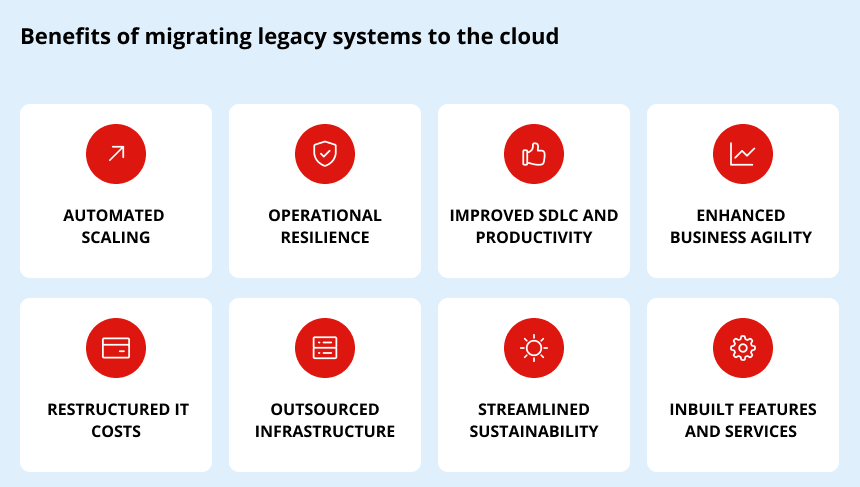
Automated scaling
Cloud providers offer on-demand autoscaling and pay-as-you-go pricing, dynamically adjusting compute, storage, and networking resources when you need it. So you don’t have to bother expanding and managing your physical infrastructure and admin team. Cloud does it for you.
Operational resilience
Along with autoscaling, cloud platforms are equipped with robust inbuilt security and infrastructure management tools. So you can create more resilient applications resistant to crashes and security incidents.
Migrating on-premises applications to the cloud may lead to up to 69% decreased unplanned downtime, according to The Hackett Group study.
Improved IT staff productivity and SDLC
In time, maintaining and supporting legacy applications becomes an uphill battle. Technical debt grows, and the code becomes more complex to understand and troubleshoot. Sooner or later, IT teams rotate and retire, taking with them the unique knowledge about the code and dependencies. This affects performance and development speed.
Modernization and migration of legacy apps to the cloud help improve development KPIs and overall SDLC. AWS reports up to 35% boost in productivity among development teams as a result of cloud adoption. This includes reduced time to release new features and applications, average SDLC time, and the number of FTEs required to manage workloads and resolve issues. Which leads us straight to the next point.
Enhanced business agility
Cloud adoption helps you embrace innovation, test new technologies, and quickly roll out new features and applications. Moving from legacy systems to the cloud is a proven way to stay competitive, relevant, and profitable. This benefit goes beyond short-term gains. It directly impacts your business outcomes and brings long-term value.

Business value of cloud modernization. Image credit: AWS.
Optimized and restructured IT costs
Migrating legacy applications to cloud platforms leads to reduced IT costs. But there’s a catch. In fact, many people misunderstand the true price of adopting cloud services.
On the one hand, you will retire your legacy investment in on-premises infrastructure — servers, spaces, and administration. This will let you reduce overhead, optimize your IT department structure, and free resources for business-critical development.
GE Oil & Gas achieved 52% IT cost reduction by migrating over 500 applications to the cloud.
On the other hand, you will start investing in the cloud, adding quite a penny to your licensing and third-party expenses. In practice, all costs combined, hosting applications in the cloud often ends up being more expensive than running on-premises infrastructure in the long term. However, the benefits of the cloud eventually offset additional costs.
Outsourced infrastructure management
It’s not easy to put together and retain a competent team that can manage, scale, and secure on-premises infrastructure. And not cheap! Especially for a non-tech company. If you run a legacy application but struggle to maintain and secure your infrastructure, moving to the cloud with a PaaS model will let you offload infrastructure management to your provider.
Sustainability
Although not the primary reason, legacy application migration to the cloud can also support your sustainability and compliance goals. AWS, for one, plans to power operations with 100% renewables by 2025. By moving your infrastructure to the cloud platform that commits to net zero, you hop on the green initiative and reduce your own carbon footprint.
Inbuilt features and services
Last but not least advantage of legacy to cloud migration is the suite of tools and services the cloud provides. Backup capabilities, data management, advanced analytics, performance monitoring and management tools, built-in security and compliance, and a long list of other features and components take off of your plate. So you can focus your resources on developing the core business functions.
The process of migrating legacy systems to the cloud is unique for every organization. It depends on your goals, the complexity of your application, available skills and resources, and many other factors. This is why the first step is so important.

Step 1. Assess
Before you get down to planning your migration, you need to assess what you have now and what you want to achieve. To do this, evaluate the current state of your legacy application and infrastructure and make a detailed inventory. Here are the main things to consider during the assessment.
Your goals
Why do you need to migrate to the cloud? Do you want to improve scalability, reliability, and security? Offload infrastructure management to a cloud provider? Perhaps, your application no longer fits your business and operational requirements and needs a major modernization? Your goals will impact the strategy, approach, and priorities for your migration journey.
Your application and infrastructure
Evaluate your legacy system from technical and business standpoints. This includes among other things:
- Current architecture and compatibility with the cloud
- Integrations with third-party services and components
- Technologies (aging frameworks that need upgrade/migration, security and compliance issues, outdated data model, etc.)
- Available documentation
- Components, data, or services that need to be retired before migration
- Business-critical and secondary components and services
On top of that, make a complete inventory of your physical and virtual infrastructure and benchmark performance, security, scalability, and other metrics you will monitor before and after you migrate legacy applications to the cloud.
Dependencies, limitations, and risks
Map the dependencies between components and services. You need to know how different parts of your application impact and depend on each other to function. This will help you break down the migration process into phases and minimize the risks of failures. I’ll show you how later in the guide, so read on.
Along with dependencies, consider other limitations you may come across. This can be anything from tight timelines and resources to resistance to change from stakeholders. Consider also operational, financial, security, and business risks of both migrating and not mitigating your legacy application to the cloud.
Skills and competencies
Missing cloud competence and tech skills can become the biggest barrier to effective migration. That’s why it’s important to assess available development resources, identify gaps, and work out the strategy to close them (e.g., staff training and certification, IT team augmentation, dedicated cloud team, outsourcing migration to a tech partner, etc.).
Step 2. Create a strategy and roadmap
Next, you build the strategy for your migration project and create an implementation roadmap based on your goals and available resources. At this step, you have to set priorities, make choices, and sometimes even trade-offs.
Choose your cloud migration approach
There are several approaches to migrating workloads and applications.
- Rehosting a.k.a. lift-and-shift is the simplest and fastest approach that implies moving an application ‘as is’ from one environment to another. It’s a viable option if you already host your application in the cloud and want to change provider. But it rarely works for migrating legacy applications to the cloud. Legacy apps, often built as monoliths, need a major revamp to become cloud-ready.
- Replatforming involves adjusting applications to fit the cloud environment without considerable rewriting or restructuring. This approach will let you take some advantages of cloud, but not all.
- Refactoring and rearchitecting your legacy application will help you maximize the capabilities of the cloud. These approaches involve redesigning and modernizing applications to create cloud-compatible, scalable, and resilient systems. This may include refactoring the codebase, breaking down legacy monolith to microservices, and containerization.
- Replacing refers to swapping a legacy application for a market-ready SaaS. Choose this option if investing in legacy modernization makes no sense from financial, technical, and business standpoints.
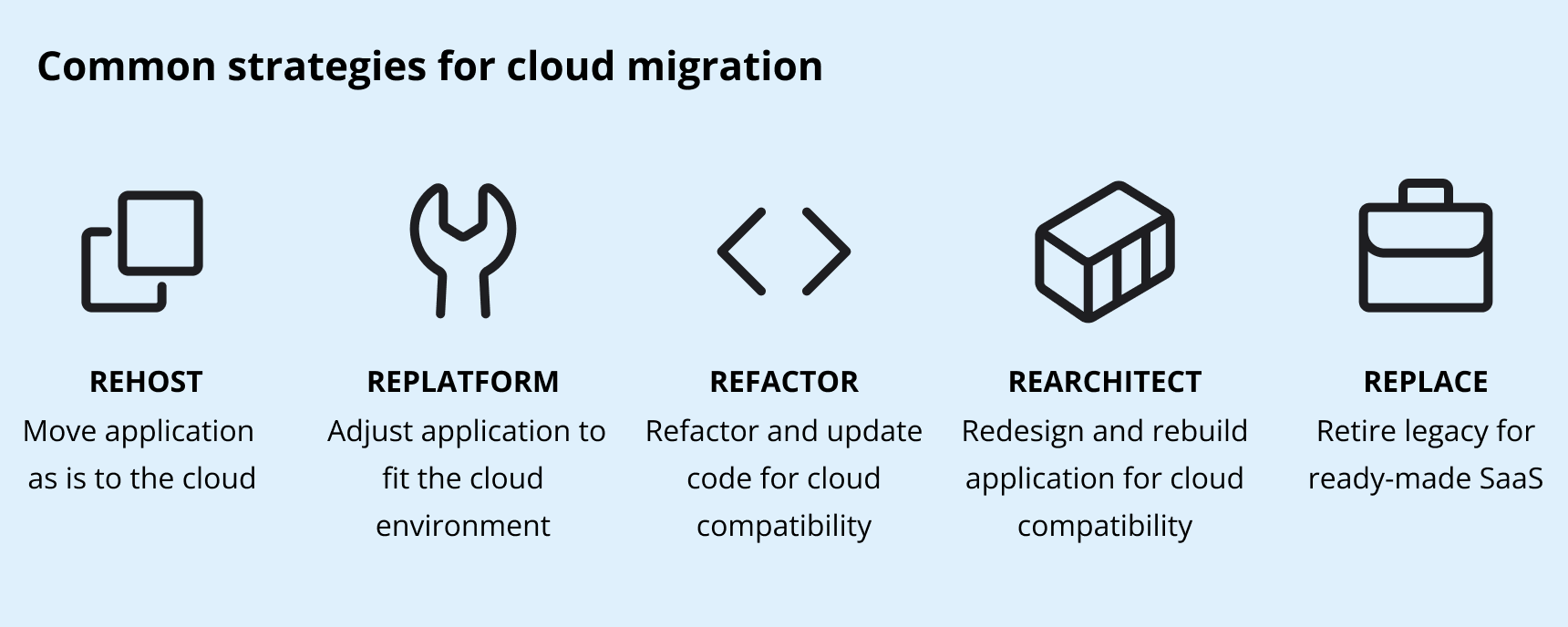
Depending on your goals, you may consider combining several approaches. This will allow you to expedite legacy migration rollout and bring value early on.
For instance, you decide to rearchitecture the core of your application, replace some components entirely, and rehost others. Or opt for a hybrid cloud approach and retain some of your on-premises infrastructure for critical components not suitable for the cloud.
Define your data migration strategy
Data migration strategy determines how to move data from your current infrastructure to the cloud. Your goal is to ensure you can do it effectively and securely while maintaining data integrity. Otherwise, it may compromise the migration process, cause added downtime, or, worse, data loss.
There are several approaches to data migration.
- Lift-and-shift to quickly move data from one environment to another (if data models are the same).
- Data replication involves replicating and synchronizing databases between environments using replication tools like Qlik Replicate.
- Building ETL pipelines to Extract, Transform, and Load data from the source environment to the target cloud. This approach applies to migrating data for complex data-heavy systems that require significant modification and processing on the way.
- Hybrid cloud data integration works for hybrid cloud projects. It refers to connecting on-premises infrastructure and the cloud to enable exchange and synchronization of data between environments.
Your choice of data migration approach, tools, and strategy depends on the type, volume, and quality of data you have and the data model you build in the cloud.
Pick your service model and tech stack
PaaS and IaaS are the common service models for hosting your application in the cloud. The main difference lies in the level of control over infrastructure you get.
IaaS (Infrastructure as a Service) places responsibility for managing computing resources on you, providing maximum flexibility to adjust your infrastructure to your needs. PaaS (Platform as a Service), on the other hand, lets you focus on application development while your cloud provider takes care of infrastructure management and resource provisioning.
FaaS (Function as a Service) allows you to build and run individual functions using cloud provider’s resources and pay precisely for what you use. And if you aim to completely replace your legacy application with a ready-made solution, opt for SaaS (Software as a Service). Your SaaS vendor manages both software and hardware.
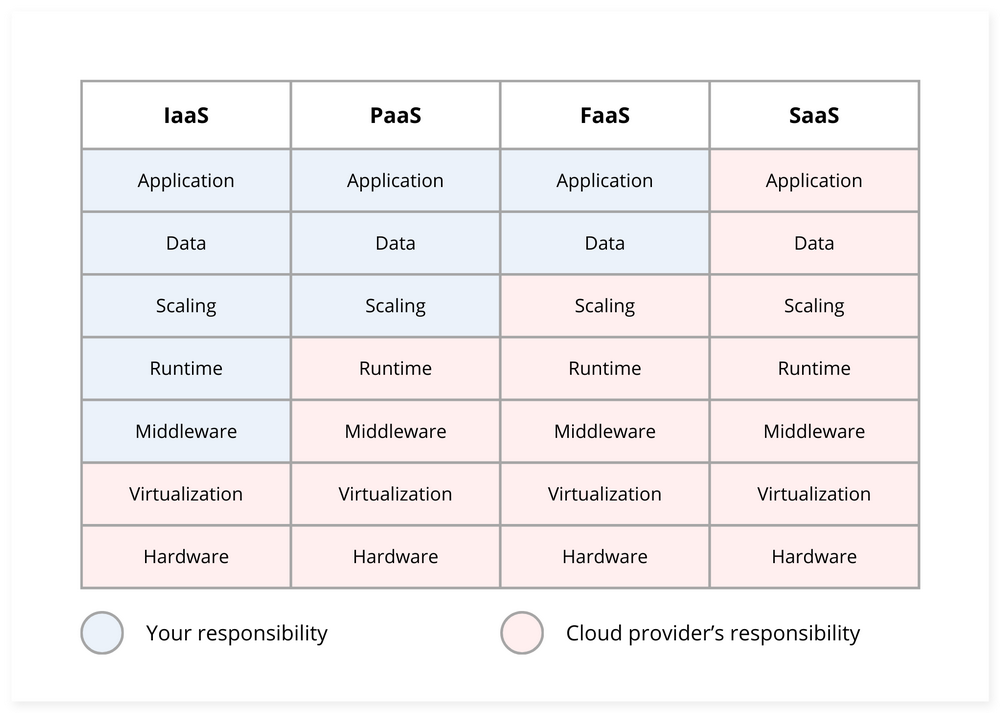
The choice of cloud provider, data management services, and other technologies involved in the migration and modernization process depends on various factors:
- Your approach to application and data migration
- Required modernization (refactoring, rearchitecting, etc.)
- Security and data compliance
- Scalability and performance requirements
- Current technologies, services, and platforms you already use in your organization
- Available competence and skills
- Cost, pricing, and service models offered by providers
- Resources and support offered by providers
Define KPIs
You have already benchmarked some metrics and know what you want to improve. Define clear KPIs that will help you evaluate the progress and result of your migration project. It can be anything from response speed and page load time to application-specific or process-specific KPIs like user retention rate or deployment frequency.
Build a migration roadmap
Cloud migration is rarely a one-and-done project. Instead of moving legacy apps to the cloud in one go, break down the workload into phases and create a roadmap for a gradual transition. Especially, if your migration project involves rearchitecting the application and adopting microservices.
Each phase involves the migration of certain components or services connected by dependencies, data, workflows, or business functions. Prioritization is key at this step. It will let you reduce time-to-value and minimize risks of unplanned downtime. More about this in the next step.
Step 3. Migrate phase by phase
Migration starts with preparing the cloud environment and configuring services and tools.
You will need to set up (if you haven’t yet) or adjust your CI/CD process to the specifics of the cloud environment. It will help you create an effective SDLC and enable rapid smooth deliveries. And configure monitoring tools to track essential KPIs and measure the result of your migration.
The general rule of thumb is to kick off with a test migration to make sure everything works as it should. It will give you space and time to establish the well-oiled migration process before you start moving business-critical components. At this point, if you come across some issues or factors you missed during planning, it won’t cause major disruption.
Once the migration process runs like clockwork, you can move on with your roadmap. Often, companies prioritize migrations that would bring measurable results and value early on. For example, performance boost, improved security, or immediate cost savings. This also helps justify the migration of legacy apps to the cloud to stakeholders.
Other factors that impact the priorities are:
- Dependencies. Migrate in one phase the components that share dependencies, data, and services.
- Criticality for business. Define business-critical and secondary components and services and prioritize their migration based on how it affects your business.
- Urgency. Some components may need to go forward, for instance, for compliance or security reasons.
And remember that migration is an iterative process. You may need to adjust your priorities at an early stage. Or modify the roadmap based on changing business needs or midway results of the project.
Move to the cloud with confidence
Future-proof your business with effective and risk-free roadmap for legacy modernization and migration.
Contact cloud expertsStep 4. Evaluate the outcome
You will achieve some goals and assess the progress during the migration. However, the actual outcome can be evaluated after fully modernizing and migrating from legacy systems to the cloud.
At this step, you can compare the KPIs with the benchmarks you set from the start. You can also assess financial, business, and operational benefits, measure technical improvements, and calculate ROI.
Moreover, using inbuilt monitoring and management tools and DevOps practices, you get control and visibility into the use of cloud resources. So you can optimize your cloud investment and costs and find ways to gain even more value from cloud adoption in the future.
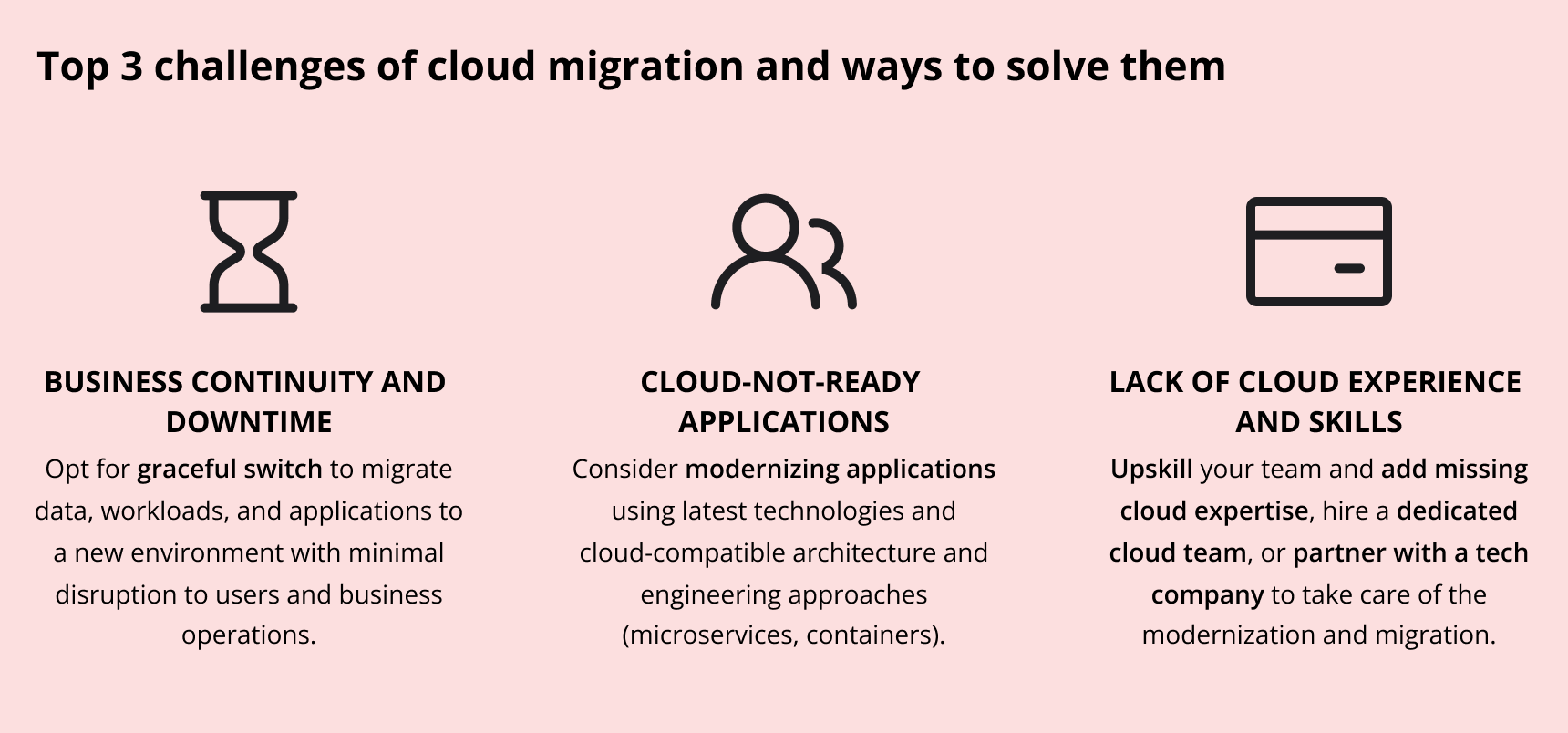
Business continuity and downtime
Complexity and operational changes are some of the most feared challenges of migrating legacy apps to the cloud. Without careful planning and strategy, the transition to the cloud may cause extended and unplanned downtime, leading to disruption of business, lost revenue, and even customers.
Solution
A graceful switch is a set of techniques and methods to migrate data, workloads, and applications to a new environment with minimal disruption to users and business operations. It involves duplicating data and users in both environments that synchronize and work in parallel. Then, gradually retiring the old system.
Cloud-not-ready applications
Running legacy applications on a cloud is like giving an old typewriter a fresh coat of paint. Sure, it looks better, but the keys are still jammed and typing is slow. To gain full advantage from the cloud, you need to adapt your application to work in this environment. This, however, often involves complete application reengineering, which can be just as complex as migration itself.
Solution
Legacy application modernization goes hand in hand with the cloud. By adopting modern architecture (e.g., microservices, serverless), DevOps practices, and orchestration tools, you can maximize the value of the cloud and fully achieve the goals you set for migration.
Lack of cloud experience and skills
Lack of relevant skills is one of the top 3 barriers to cloud adoption reported by over 800 IT executives across the globe. Finding specialists who could build and implement an effective strategy for migrating a legacy application into a public cloud or hybrid environment is not easy. Especially for companies that don’t have tech leadership and tech teams in-house.
Solution
If you do have a reliable IT team looking after your on-premises infrastructure, consider upskilling, restructuring, and adding missing cloud expertise. Alternatively, you can hire a dedicated cloud team with the right mix of tech and business skills and operations experience. Or partner with a proven tech company that can provide scalable development resources and take care of the entire modernization and migration.
External partners will lead or completely handle around 70% of modernization and cloud adoption projects in the following years, according to the Red Hat survey.
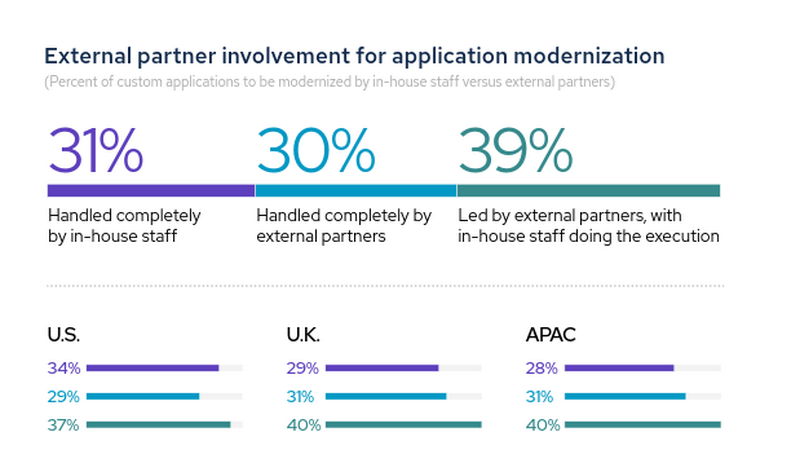
Image credit: Red Hat.
If you are considering legacy app modernization and migration to the cloud but don’t know where (or how) to start, we can help. We already support some of the market-leading companies like Printique, Oxford University Press, and Lodgify to adopt and scale their cloud capabilities successfully. Depending on where you are in your journey, we can help you reach your goals by:
- Building a fail-proof strategy and roadmap for smooth and effective cloud adoption (Google Cloud, Microsoft Azure, AWS, or hybrid approach).
- Modernizing your legacy applications to make them scalable, flexible, and cloud-ready.
- Refactoring your applications with modern technologies and migrating to modern architecture (microservices, serverless).
- Implementing end-to-end legacy to cloud migration while keeping your business operational.
- Scaling up your tech team or assembling a dedicated cloud team to support your modernization and migration initiatives.
Become more scalable, competitive, and profitable
Modernize your applications and workflows and adopt cloud with a reliable tech partner.
HIRE CLOUD EXPERTSAfterthought
We walked through the process of migrating legacy applications to the cloud and touched upon some of the most feared challenges of this journey. There’s one more note I want to add.
Cloud migration involves not only changes in technologies, teams, and workflows. It’s a fundamental reformation that may impact how things work in your company. It opens new opportunities for innovation, automation, and digital transformation. But it also requires guided change within the organization.


